Skulls of the Shogun Review
A welcome change of pace from usual strategy genre entries
The Ghast Samurai
Had I not known that I was dead already,
I would have mourned the loss of my life.
Ota Dokan, a famous samurai-monk, composed that poem right after he was sentenced to death in 1486. In Japan’s feudal era, it was common for learned samurai to compose such jisei, or death poetry, when they felt their end’s approach. But if the afterlife is anything like its portrayal in Skulls of the Shogun then they might not have been in such a hurry to put pen to paper. In 17-BIT’s inaugural strategy game, death means taking up one's spot at the end of the line into the afterlife proper. The current wait time? Just a few thousand years or so.
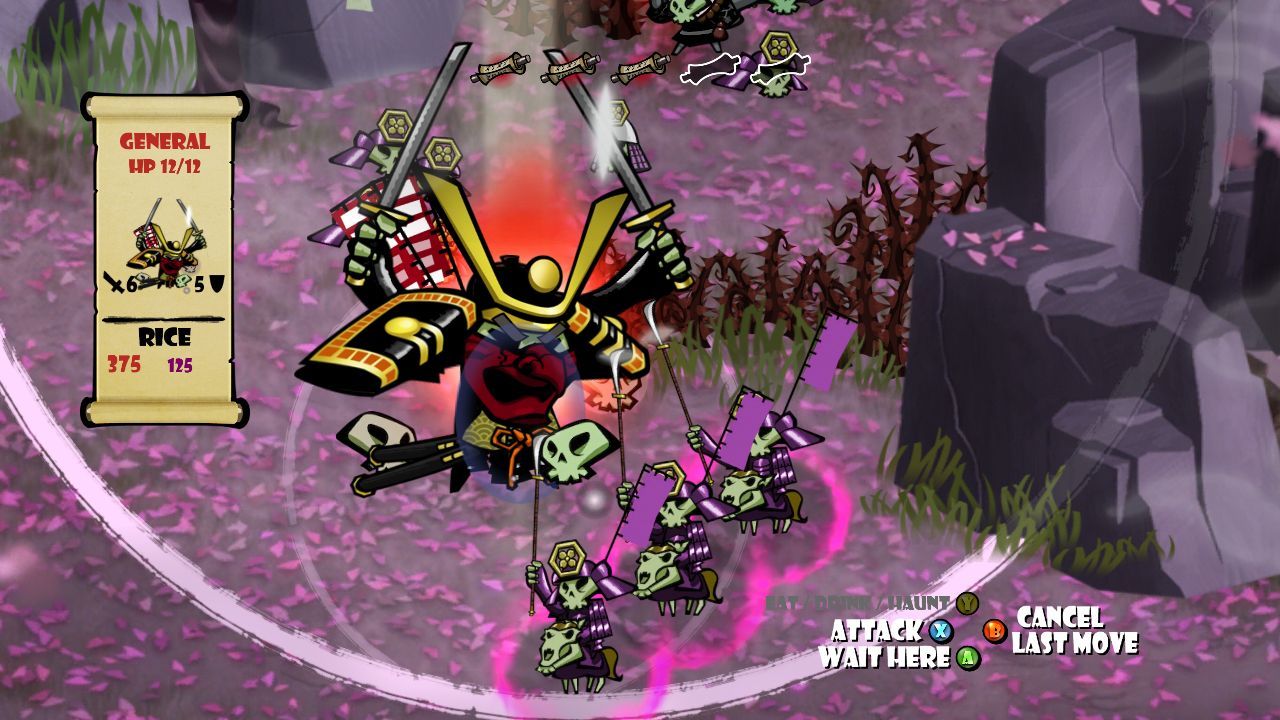
That’s the situation that bloodthirsty General Akamoto finds himself in when he’s backstabbed by his second-in-command mere seconds after his greatest victory. But in life, so it goes in death, and Akamoto isn’t the type to wait patiently for his turn. So when he learns that his betrayer has died, stolen his identity, and risen to the rank of non-corporeal generalissimo, it’s time to recruit some hirelings and stage a little rebellion.
Said rebellion plays out across a netherworld of floating islands (think: Toejam and Earl) that represent the changing seasons. It's a distinctly poetic metaphor for this march through the afterlife, and it lends itself to a gaming convention that'll instantly be familiar to most players: the "water stage", "ice stage", et al. Cultural features intertwine adroitly with themes of ghostliness to embellish the core strategy mechanics in Skulls of the Shogun. Rice paddies and temples can be “haunted” to procure resources and units respectively. A cast of colorful samurai, a few mischievous gods, and a creepy, voluptuous muse all await along the path towards sweet, sweet revenge.
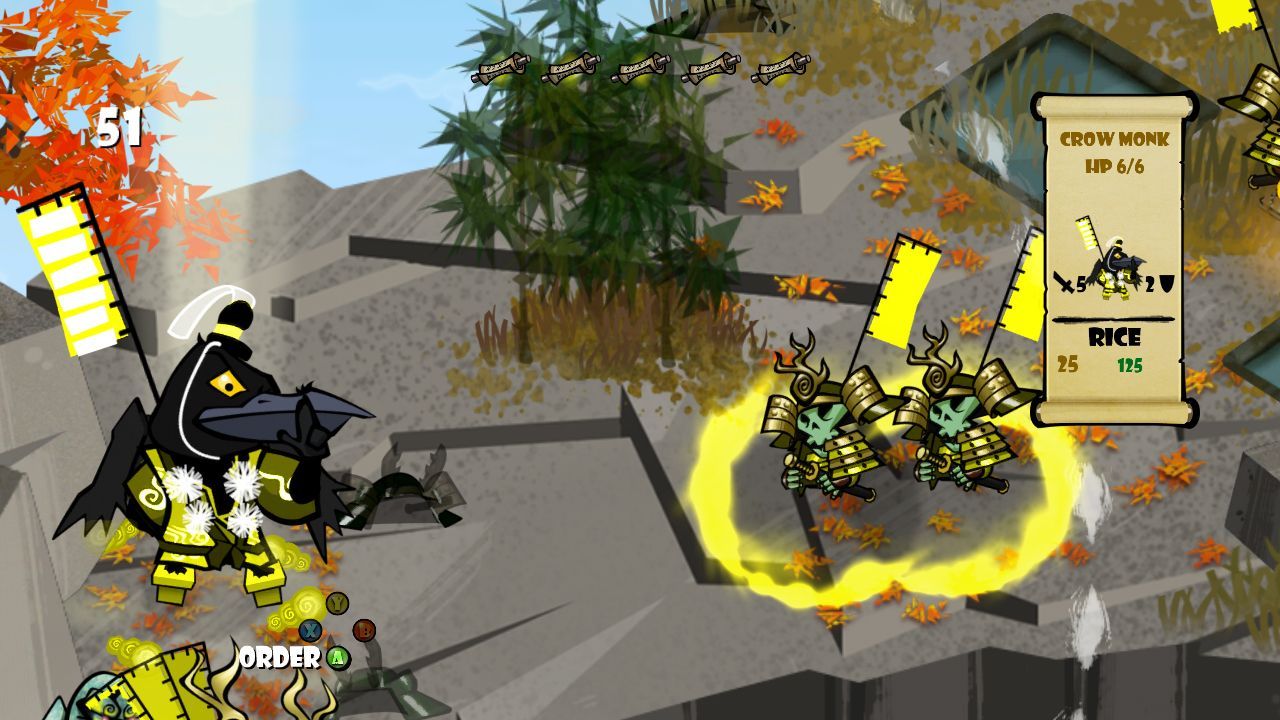
War, betrayal, death, and eternity...it would all be a bit heavy, were it not for Skulls of the Shogun’s playful humor and cartoon-goth art style. Between the two, they put a comedic spin on what are traditionally considered to be a pretty dour setting and subject matter. A lot of humor is mined from gaming tropes and samurai lifestyle; a personal favorite is a late-game battalion that speaks entirely in incomprehensible haiku. Unsurprisingly, the fourth wall remains standing about as long it takes to start the first level and meet your troops. Each battle, Akamoto and his opponent-du-jour field a varied host of skeleton infantry, cavalry, archers, and monks, all rendered with oversized heads and stubby little feet. When struck by an attack they emit high-pitched squeals of surprise as their bodies explode, leaving feckless (but still rather talkative!) skulls.
Skulls do more than simply lend gravitas to the game’s title. An enemy’s can actually be consumed by slightly more lively warriors for a quick boost of health and some new abilities. Monks that feast on their foes' remains are granted new spells, and all units, upon consumption of their third skull, become demons that can act twice per round. It's a mechanic that's of deep consequence to the strategic underpinnings of Skulls of the Shogun - losing units empowers the enemy, compounding the damage inflicted when a soldier is felled. This, and a number of other simple, but beneficial design decisions help Skulls of the Shogun stand out from the crowd, while still maintaining the depth and balance that are genre pillars. Capable tacticians will find a bevy of tools that must be juggled and fought over to achieve victory.
For his part, Akamoto himself can seem hapless enough to make one wonder how he had any success when alive. He’ll spend most of his time asleep at the rear of your army, and though this rest boosts his maximum health each turn, the claim that he’s simply “meditating” doesn’t stand up to the audible snoring. He blusters with sophomoric insults, and he falls for enemy ploys that his own soldiers see a mile away. Akamoto may be lacking for brains, but awaken him from slumber and you'll quickly come to appreciate his brawn. Generals can take two actions each turn (and even more if they've consumed the requisite skulls), making them ferocious combatants. But the general is also the King in this game of chess - his death results in an instant loss. It layers on yet another tactical dilemma: "Do I call on my general's services, or keep him well-defended at the rear?” Complicating matters further are intermittent enemy sneak attacks at your back that always seem to come when you’re overextended.
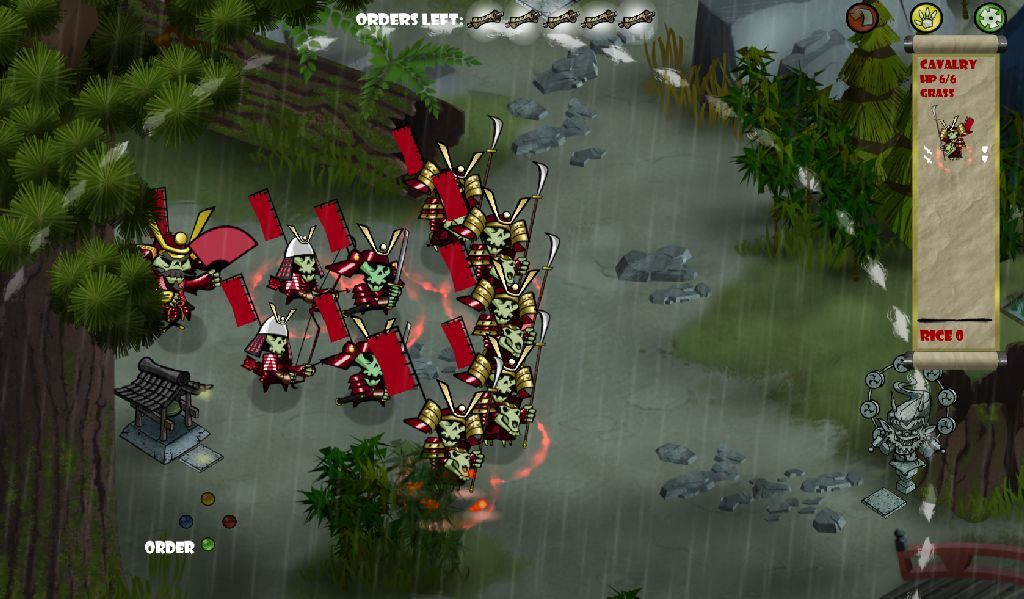
That, and an assortment of other wrinkles can make defensive warfare a tempting choice. Turtling up can be an effective strategy, particularly during later stages when the odds are stacked most heavily against you. Adjacent units can form "spirit walls", a phalanx maneuver that blocks enemy movement, increases defense, and reduces knockback. It's a critical technique, but best be careful with its application - a poorly conceived spirit wall is a Maginot Line just waiting to be sidestepped. Mercifully, the enemy AI doesn’t have much of a mind for coordinated attacks, so it’s often savvy to maintain formation while it batters single units against your lines ineffectually. Doing so means ceding the rice fields and unit-spawning temples to your opponent, but your troops can often hold their own by feasting on the garden of bones that builds up before your lines. When the enemy eventually exhausts its reinforcements, it tends to crumble quickly in the face of a demonic counter-attack.
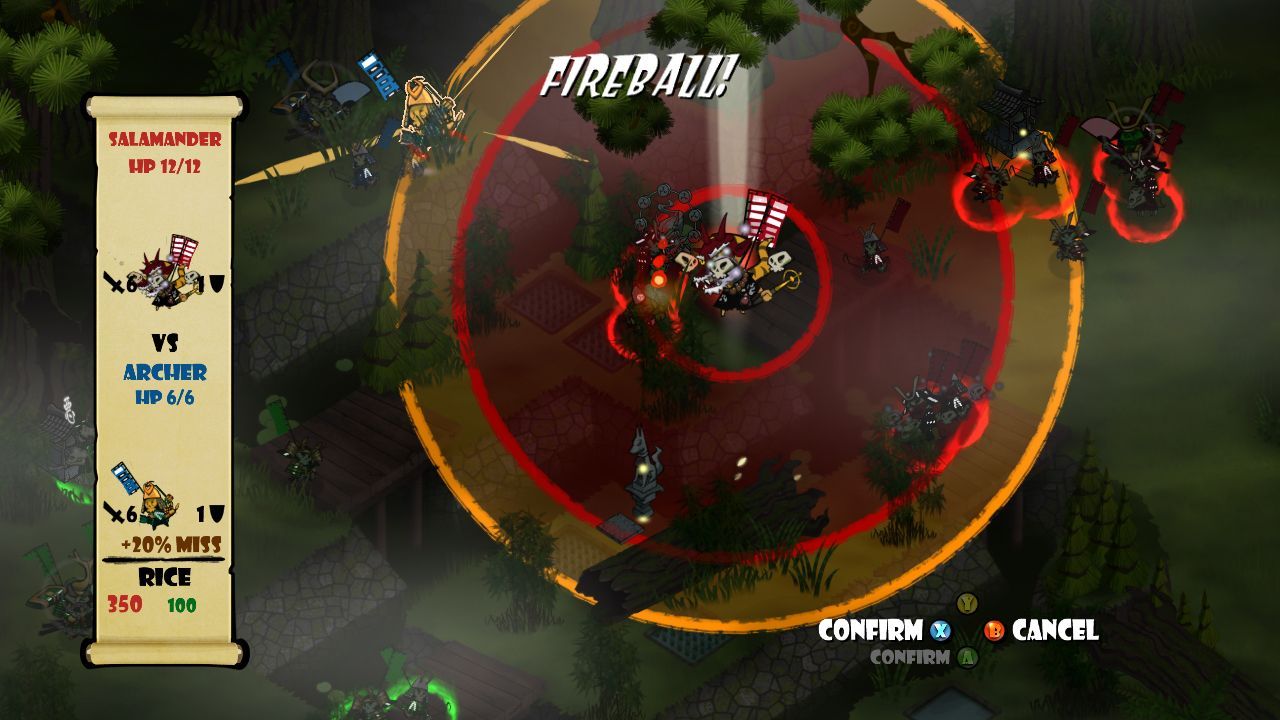
It’s also of note that Skulls of the Shogun has a cap on the amount of actions that you can take per turn, regardless of your number of troops. Both you and your opponent get five unit actions, each consisting of an option to move, and an option to use an ability (attack, magic, skull-cannibalism, etc.). Consequently, there’s a diminishing return effect on army size. Superfluous troops confer upon you little benefit; they end up just being skulls milling about, ripe for the enemy’s taking. Not the most intuitive system, perhaps, but the logic begins to show after just a few matches. Absent the cap, battles would have devolved into tiresome arms races, mini-cold wars where each side spends the better part of the engagement just building away. In an unexpected twist, the player’s understanding of efficient turn usage may be their greatest advantage over Skulls of the Shogun’s artificial intelligence. In a stage near the end of my campaign playthrough, an enemy monk made the curious decision to dally near a weapon emplacement that continually struck him with a trivial bit of damage each turn. Rather than retreat, fox monk would remain in firing range and expend an action to heal itself, essentially wasting a single one of the AI’s moves each turn. I elected to leave the monk alive, and enjoyed a critical one turn advantage for the full duration of the level. That’s an extreme example of the sort of mismanagement you’ll encounter, of course, but you’re like to raise an eyebrow at the AI’s lack of survival instincts more than once.
Battles of attrition aren’t the end-all-be-all in Skulls of the Shogun, thankfully. The levels do manage to strike a competent balance, gerrymandering the starting conditions so that timely aggression can be the most prudent option on occasion. The enemy’s general is as vulnerable as your own, and many a stage can be beaten through a sudden cavalry charge, volley of arrows, or knockback attack that catches the leader unawares. Other environmental effects, like lightning strikes, avalanches, and berserking oni also periodically emerge to help to keep both sides from resting on their laurels too much. And you won’t balk for fear of losing a prized unit to the odd reckless move, since you’re imparted with a new set of minions each level.
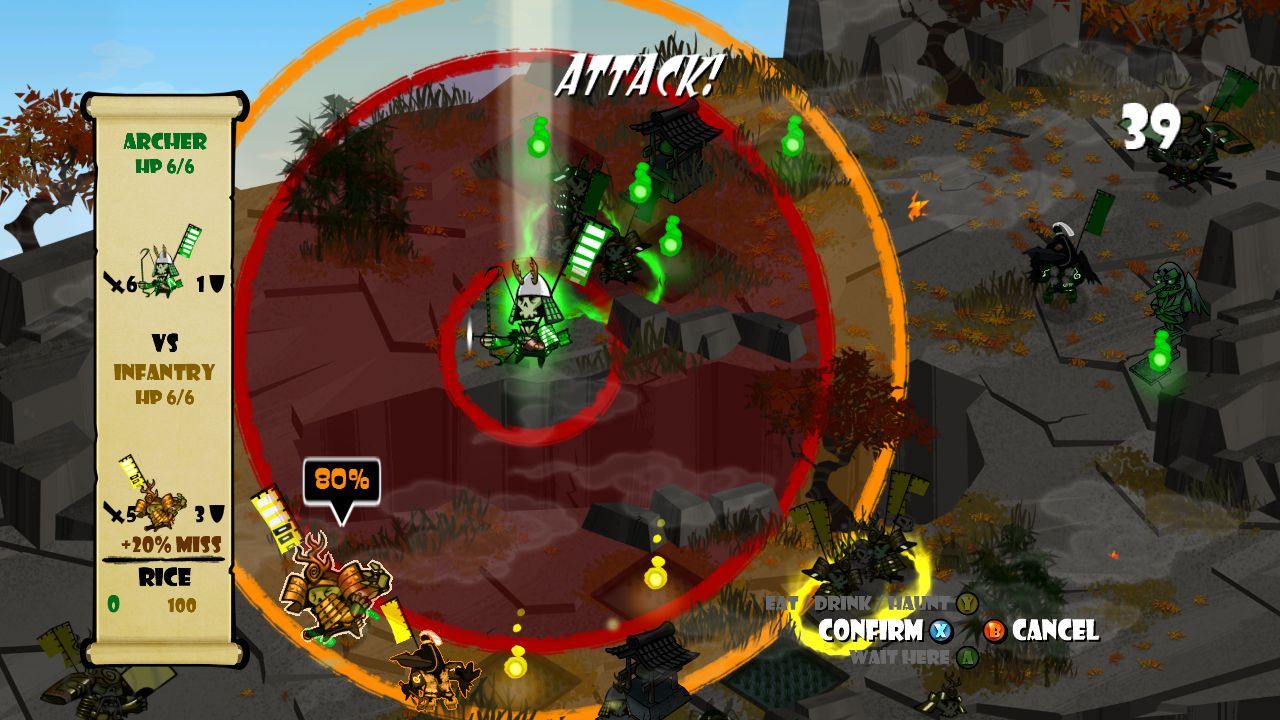
That’s for the best, because positioning can be a little finicky on occasion. Maneuverability isn’t always discernible at a glance, so it’s sometimes necessary to experiment with a unit’s range of movement to gauge whether they’ll actually be able to get around obstacles. It can also be a little hard to tell when your units are behind cover. Thankfully, such occurrences are remarkably atypical, considering the peculiarities of the user interface. Skulls of the Shogun opts for a stylized UI that doesn’t allow for the sort of exacting control that one would get with a grid or hex-based strategy game. Here, a unit’s range of movement is represented by an immutable circle that makes no concessions for changes in terrain. Consequently, the flattened, two-dimensional graphics sometimes result in maps that look like impossible objects, optical illusions where concepts like depth and height distort to accommodate the units’ circles of movement, not the other way around.
I found this distortion incredibly compelling, though I could envision it frustrating those who prefer their strategy games a bit more Cartesian. Skulls of the Shogun makes good sport of defying such conventions, from its irreverent humor through to its extraordinary mechanics. There’s a cohesion to its nonconformity, an unspoken manifesto against the tyranny of the anachronistic grids and random number generators that have held sway over the strategy genre for far too long.
 Comments
Comments











